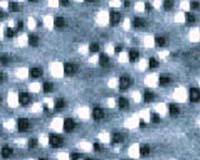 |
Copenhagen, Denmark (SPX) Apr 04, 2011 How would you like to store all the films ever made on a device the size of an I-phone? Magnets made of just a few metallic atoms could make it possible to build radically smaller storage devices and have also recently been proposed as components for spintronics devices. There's just one obstacle on the way. Nano-sized magnets have only been seen to work at temperatures a few hairs above absolute zero. Now a chemistry student at the University of Copenhagen has demonstrated that molecular magnets using the metals ruthenium and osmium retain their magnetic properties at higher temperatures. Most likely due to the larger spin-orbit coupling and more diffuse electron cloud present in these heavier elements. Some of his findings have recently been published in Chemistry - A European Journal. Kasper Steen Pedersen is studying for a Masters degree at the University of Copenhagen. Like many others in his chosen field of molecular magnetism he had been working with magnets based on 3d metal ions from iron. This seems an obvious choice when working with ordinary magnets which usually consist of about a trillion atoms. Single-molecule magnets are isolated molecules behaving like real magnets but they do not exhibit a three-dimensional order characteristic of a magnet. Though interesting from a perspective of fundamental research, the need for very low temperatures make the miniscule magnets useless for any practical applications. So Pedersen wanted to see if another tack was possible. "When you take a look at the periodic table of the elements the solution seems obvious. Ruthenium and osmium are in the same group in the periodic table as iron, so it ought to be possible to create magnets out of these substances as well by using our knowledge about molecular magnets based on iron" says Pedersen. As it turned out the chemical synthesis needed to build molecular magnets out of the substances was relatively simple. But the measured properties were surprising. "The chemical properties are the same for these metals as for iron. But the physical properties of the new magnets turned out to be very different from those made of iron. Basically, the magnetism arises from the electron spin but also from the motion of the electron around the nucleus. "The latter contribution, which is very large for ruthenium, osmium and other heavy elements, has been largely ignored by the scientific community but we have now shown, experimentally, that is a very pronounced effect. And this is utterly new and exciting", explains Kasper Steen Pedersen. Using the unconventional metals for his magnets enabled Pedersen to raise the critical temperature only by a few Kelvin. However, the intriguing result that electron motion plays a large role for the magnetic properties paves the way for new synthetic approaches to molecular nanomagnets with unprecedented high critical temperatures. "You'll not get me to call this a breakthrough. But it is a remarkable result for the field", concludes Kasper Steen Pedersen. Some of his results have been published in Chem. Eur. J. 2010, 16, 13458-13464.
Share This Article With Planet Earth
Related Links University of Copenhagen Nano Technology News From SpaceMart.com Computer Chip Architecture, Technology and Manufacture
 Twinkle, Twinkle, Quantum Dot - New Particles Can Change Colors And Tag Molecules
Twinkle, Twinkle, Quantum Dot - New Particles Can Change Colors And Tag MoleculesColumbus OH (SPX) Mar 30, 2011 Engineers at Ohio State University have invented a new kind of nano-particle that shines in different colors to tag molecules in biomedical tests. These tiny plastic nano-particles are stuffed with even tinier bits of electronics called quantum dots. Like little traffic lights, the particles glow brightly in red, yellow, or green, so researchers can easily track molecules under a microscop ... read more |
|
| The content herein, unless otherwise known to be public domain, are Copyright 1995-2010 - SpaceDaily. AFP and UPI Wire Stories are copyright Agence France-Presse and United Press International. ESA Portal Reports are copyright European Space Agency. All NASA sourced material is public domain. Additional copyrights may apply in whole or part to other bona fide parties. Advertising does not imply endorsement,agreement or approval of any opinions, statements or information provided by SpaceDaily on any Web page published or hosted by SpaceDaily. Privacy Statement |